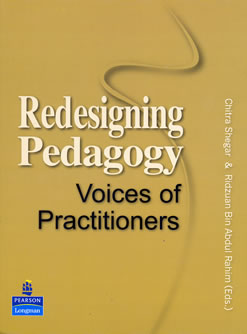Why Singapore’s English Teachers Should Embrace Singlish, Not Fight It
Is it time for Singaporean educators to embrace Singlish as a legitimate learning tool? What the Research […]
Read More
Edited by Chitra Shegar and Ridzuan Bin Abdul Rahim (2007), Pearson Education South Asia, ISBN: 978-981-06-0994-8, 168 pp.
SingTeach talks to Chitra Shegar and Ridzuan bin Abd Rahim from the Centre for Research in Pedagogy and Practice (CRPP) about their new book.
Editor’s note: This article is the first of a new series called “Read My Book”, featuring interviews with NIE academics and researchers about the stories behind their latest publications. What better way to share a new book than to hear about it from the authors and editors themselves?
 Q: Why did you decide to publish this book?
Q: Why did you decide to publish this book?Chitra: At the Redesigning Pedagogy conference, we found that there were several presentations showcasing good innovative pedagogies. Since an important objective of CRPP is to keep teachers abreast of the latest developments in pedagogy, based on established theory and research findings, we decided that these presentations should be compiled into an anthology.
Chitra: Various presentations made at the conference discussed the global economy and educational implications accruing from it. We decided to select articles that dealt with paradigm shifts that teachers have to make in pedagogy to prepare students for the globalised world.
Ridzuan: We would like to highlight two chapters. Both have to do with using information technology. The first one is on music teaching while the second is on mathematics teaching. Many of the ideas discussed in these chapters are applicable or can be transferred, with some thought, to other disciplines.
The first one by Eddy Chong and Soo Wai Man illustrates the use of blogging in giving students opportunities to “voice” their opinions. The blogging platform allowed these students to participate in discussions outside the classroom where the pressure of public speaking is off and students have more time to compose their thoughts. We find this particularly important in classrooms in Singapore because generally our research indicates that there are few opportunities for extensive class discussions; and even when teachers create such opportunities, they tend not to be taken up by students.
The second chapter worth highlighting is by Cynthia Seto, Lisa Goh and Tok Bing Hwee. We find the argument to shift the balance of pedagogical approach from a teacher-centred to a learner-centred environment by integrating the use of information technology into classroom practices rather compelling. The authors clarify the differences between the two approaches and illustrate them with two examples. The chapter also discusses in detail how the lesson with a learner-centred environment is carried out. Read it!
Ridzuan: The globalised world has impacted education in a big way so as to require paradigm shifts in pedagogy. The articles in this book provide practical examples for teachers so they can also try out innovative pedagogies in their classrooms that are aligned with new educational paradigms.
Redesigning Pedagogy: Voices of Practitioners fills in the publications gap between lesson plan type of materials and academic journals that are available. It invites teachers to partake in a learning journey that strikes a balance between theory and practice. We hope that this book can be a platform and catalyst for professional discussions amongst teachers so that they can make continuous improvements in their teaching.